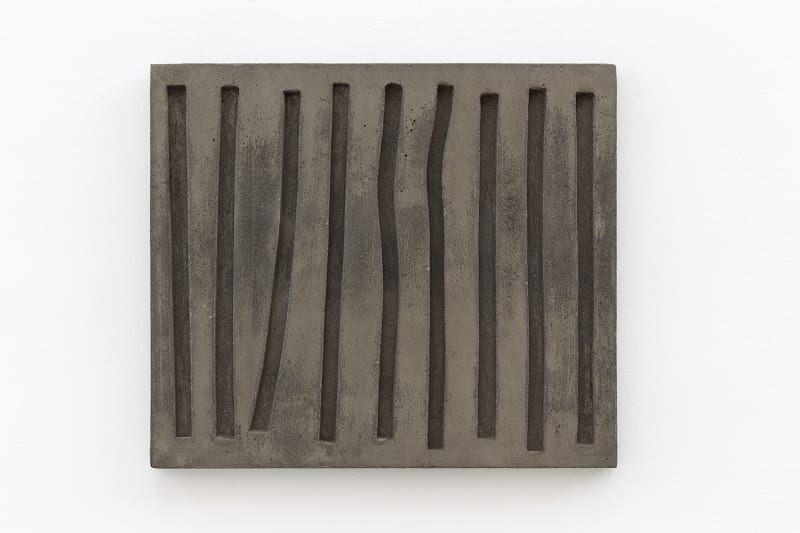Anna Maria Maiolino (Scalea, Italy, 1942). Printmaker, painter, sculptor, multimedia artist and designer. Through a work with a political and provocative bias, Maiolino investigates different materials and explores various means of expression, such as woodcut, photography, film, installation and performance.
In 1954, due to the shortage caused by the post-war period in Italy, she moves to Caracas, Venezuela, where she studies at the Escuela de Artes Plásticas Cristóbal Rojas from 1958 to 1960, year in which she moves to Brazil. In 1961, she began a course in wood engraving at the Escola Nacional de Belas Artes (Enba) in Rio de Janeiro. Despite her Italian origin, Maiolino's artistic formation is mainly Latin American.
In 1963, she takes engraving classes with the artist Adir Botelho (1932), and in the same period she attends Ivan Serpa's (1923-1973) atelier, at the Museu de Arte Moderna do Rio de Janeiro (MAM/RJ). The following year, she held her first solo exhibition at Galería G, in Caracas. In 1967, she participated in Nova Objetividade Brasileira, an exhibition that, among other precepts, proposed overcoming the easel painting in favor of the object. The event wasorganized by critics and artists, among them Hélio Oiticica (1937-1980), who is also part of Nova Figuração, a movement that reacts to abstraction and takes a position before the Brazilian political moment, which Maiolino joins in the 1960s.
In this phase, the artist concentrates on woodcut, parallel to the production of objects. The landscapes, the interior scenes and the large white areas demarcated by softly cut black figures give way to narrative colored figuration with urban themes and/or related to daily life and the condition of women. An approach to popular culture is noted in herinterest in the engraving of cordel pamphlets, combining her graphic style with social and political themes.
In 1968, she moved to the United States, where she stayed for about three years and studied at the Pratt Graphic Center in New York. In the 1970s, upon returning to Brazil, she began to work with various media, such as photography and film. She participates in the 1st Festival do Filme Super-8 in Curitiba, Brazil, and receives an award for In-Out, Antropofagia (1974), her first video work, which brings into question issues such as censorship and freedom. She also participates in the Super-8 International Film Festival, at Space Cardin, in Paris; in the 5th Jornada Brasileira de Curta-Metragem, in Salvador; and in the 2nd Festival Nacional de Curta-Metragem, at Alliance Française du Brésil, in Rio de Janeiro.
Still in the 1970s, Maiolino explores experimental poetry, which quickly leads her to drawing. [1] Her keynote is the investigation of the materiality of paper and the limits of its spatiality. The figure leaves the scene and gives way to new elements, such as cuts, folds, seams with thread, written words, and engraved incisions. The sheet is explored in its sensitive existence in space, sometimes being worked on both sides. From this phase are series such as Mapas Mentais (1971) and the object drawings Buracos Negros (c.1974), in which the personal and political planes are amalgamated.
At the end of this decade, the artist began to dedicate herself to performance. She presents Mitos Vadios (1978) in a vacant lot on Augusta street, in São Paulo. She also makes installation works such as Feijão com Arroz (1979) [2] and Entrevidas (1981), which takes over Cardoso Júnior street so that the public dribbles a "mine field" made of dozens of chicken eggs scattered on the ground.
Other forms of expression experimented by Maiolino, from the 1980s on, are painting and working with clay, being the second one influenced by the Argentinian artist Victor Grippo (1936-2002). This movement, in a way, announces herconcern with gesture and the relationship with matter, present in the sculptural wall objects and reliefs (in clay, plaster, and cement) of the early 1990s. She receives the prize of best exhibition of the year from the Associação Brasileira de Críticos de Arte (ABCA), in 1990, for an individual exhibition held at Centro Cultural Cândido Mendes (CCCM) in 1989.
Little by little, Maiolino concentrates on the manual aspect of making art and begins to use clay almost exclusively. She elaborates projects with a great quantity of this material, in which the repetition of gesture and its register in the material signalizes an enormous concentration of energy. Installations such as Muitos (1995) or São Estes (1998) place the body at the center of the artwork, while transforming the unmemorized gesture of everyday life into a reservoir of experience.
In 2002, she holds a retrospective exhibition in New York, accompanied by the book A Life Line/Vida Afora. In 2008, she participated in the 16th Biennial of Sydney, Australia, and in 2012, she presented the installation Here & There at Documenta 13, in Kassel, Germany, a work derived from previous assemblies of Terra Modelada, a series that began in the 1980s.
Anna Maria Maiolino's work in the field of visual arts addresses political, urban, and everyday issues, and refers to the role of women. The performance in several forms of expression promotes an investigation about the process of making art.
Notes
1. Drawing represents a central vein in Anna Maria Maiolino's production. In 2002 the artist receives a retrospective of her works on paper at The Drawing Center, in New York. The show Anna Maria Maiolino: A Life Line/ Vida Afora, curated by the then director of the institution, Catherine de Zegher (1955), includes almost 35 years of her career, in recognition to the importance of her contribution to the expansion and updating of this technique.
2. The installation was shown again in 2003 at the Atelier Finep program at Paço Imperial, in Rio de Janeiro, and at the 29th Bienal de São Paulo, in 2010.
ANNA Maria Maiolino. In: ENCICLOPÉDIA Itaú Cultural de Arte e Cultura Brasileiras. São Paulo: Itaú Cultural, 2021. Available at: <http://enciclopedia.itaucultural.org.br/pessoa9539/anna-maria-maiolino>. Accessed on: June 25, 2021. Encyclopedia entry. ISBN: 978-85-7979-060-7

